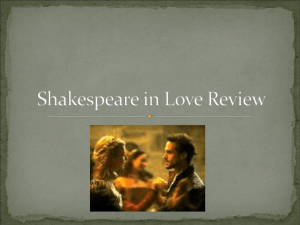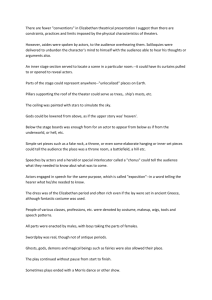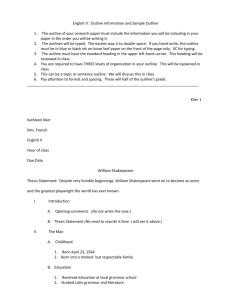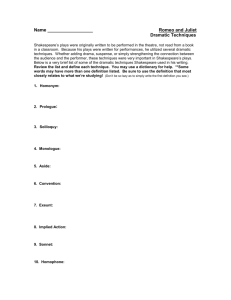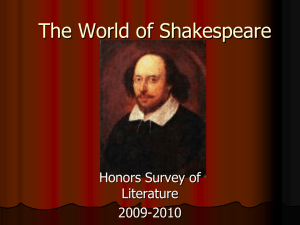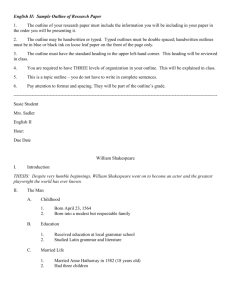Shakespeare and His Theater
advertisement
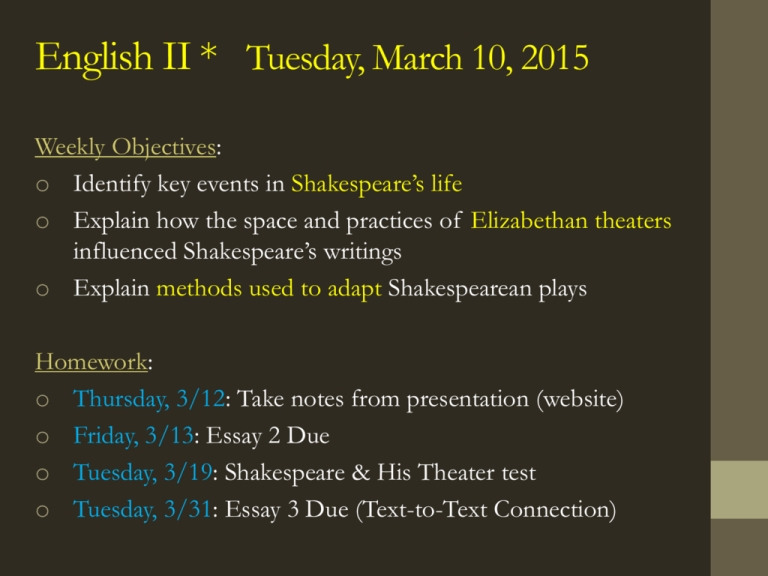
English II * Tuesday, March 10, 2015 Weekly Objectives: o Identify key events in Shakespeare’s life o Explain how the space and practices of Elizabethan theaters influenced Shakespeare’s writings o Explain methods used to adapt Shakespearean plays Homework: o Thursday, 3/12: Take notes from presentation (website) o Friday, 3/13: Essay 2 Due o Tuesday, 3/19: Shakespeare & His Theater test o Tuesday, 3/31: Essay 3 Due (Text-to-Text Connection) English II Ms. Spinelli March 2015 Part I: Shakespeare’s Life During what time period did Shakespeare live? Where was Shakespeare born? What was the name of Shakespeare’s wife? A. General Information i. Born in Stratford upon Avon in 1594 ii. Resided in London most of life iii. Died at 52 years old in 1616 B. Education i. Finished school at approx. 13 years old ii. Curriculum focused on Latin & grammar Interior of the Shakespeare home William Shakespeare’s childhood home Stratford Grammar School House C. Marriage i. Married Anne Hathaway (26) at 18 years old ii. Left wife and four children to become actor Anne Hathaway’s childhood cottage A German illustration depicts Shakespeare surrounded by his children, who listen entranced to his stories. Anne is portrayed as an idealized housewife, sewing a garment. “Good friend for Jesus sake forbear To dig the dust enclosed here! Blest be the man that spares these stones, And curst be he that moves my bones.” Part I: Shakespeare’s Life What was Shakespeare’s involvement in the theater? What was the name of his acting troupe? What literary forms is Shakespeare best known for? D. Career i. Actor 1. Formed Lord Chamberlain’s Men, which later became The King’s Men 2. Main dramatist and part-owner of the Globe Theater D. Career (cont.) ii. Writer 1. Wrote 37 plays a. Comedies: Much Ado About Nothing, Taming of the Shrew b. Tragedies: Hamlet, Macbeth, and Julius Caesar c. Histories: Richard III, Henry IV 2. Wrote 150+ sonnets a. 14-lined poems b. Written in iambic pentameter c. ABAB-CDCD-EFEF-GG rhyme scheme Hamlet Romeo & Juliet The Taming of the Shrew Twelfth Night Part II: London Theater What kind of reputation did actors have? What kind of reputation did playwrights have? What was the government’s role in performances? A. History i. Rebirth of learning & interest in classical world ii. Actors had poor reputation – considered vagabonds and rogues iii. Plays i. Queen forbid performances on religious and political subjects ii. Shift to topics of classical literature and history iii. Playwrights rarely sought publication; plays weren’t considered literary works Part II: London Theater Describe the aspects of a theatrical performance. Other than actors, what else might be included? Can you think of public entertainment – other than plays – that people often attend? Name three types of stages. Advantages? Disadvantages? Advantages? Disadvantages? Advantages? Disadvantages? Part II: London Theaters How does the State Theater compare to the Globe Theater? The Globe Theater The State Theater B. Types of Theaters i. Arena Stage 1. Audience sits on all sides of a performing stage 2. Advantages: Intimacy of enclosing action 3. Disadvantages: Prevents elaborate sets, audience sees entrances and exits B. Types of Theaters (cont.) ii. Thrust Stage (i.e. Globe Theater) 1. Audience around three sides of a raised platform 2. Audience: all levels of society Fresh Prince: Breaking the Fourth Wall B. Types of Theaters (cont.) iii. Proscenium Stage (i.e. State Theater) 1. Architectural arch frames theater, creating a ‘fourth wall’ into which spectators view the action 2. Stage became more narrower and shorter in length Part II: London Theaters How frequently did playwrights produce new plays? When were performances scheduled? What was the atmosphere like during a typical performance? C. The Plays i. Schedule 1. Two companies often played at once 2. Performed six days a week at 2 PM 3. Constant demand for scripts to keep audience ‘tuned in’ ii. Atmosphere i. Plays were bawdy ii. Audiences were rowdy Part II: London Theaters What are the defining characteristics of language in a Shakespearean play? C. The Plays (cont.) iii. Language 1. Dramatic poetry - formal, elevated speech 2. Mostly blank verse (unrhymed poetry) 3. Lower-class characters given lines of prose (paragraph-style) with slang Shakespearean Insults (6:23) Part II: London Theaters Why were there few props and backdrops for most performances? How, then, was location established? What did the actors wear? C. The Plays (cont.) iv. Set i. ii. iii. iv. v. Few props & backdrops because of transitory plays and actors Props only for functional use; often left onstage No curtains Location established through dialogue Special effects: fireworks, animal blood, music C. The Plays (cont.) v. Costumes i. Most valuable asset in a company ii. Made by company, bought in London, or donated by courtiers iii. Elizabethan garments, regardless of play’s historical era doublet breeches ruff kirtle Part II: London Theaters Why did Shakespeare’s acting troupes include the names of men (i.e. Lord Chamberlain, the King)? If all actors were male, who played female characters? How was the audience convinced of their roles? Which characters were popular among the ‘groundlings’? C. The Plays (cont.) vi. Actors 1. Troupes a. Companies petitioned noblemen to claim actors as servants b. Those not part of a guild were considered ‘masterless men’ c. Theater opposition lead to performances outside of city limits C. The Plays (cont.) vi. Actors (cont.) 2. Gender a. Only men (women forbidden to be on stage) b. Female characters played by prepubescent boys 3. Casting a. Often double-casted b. Popular actors earned more money and praise c. Clowns and jesters were popular with the groundlings Part II: London Theaters What skills were required of actors in Shakespeare’s time? 4. a. b. c. d. Required skills Stunts Sword Fighting Dancing Projecting voice without microphone Part III: The Globe Theater Who created the first Globe Theater? Why was it destroyed not once, but twice? Describe the building structure. After what was this theater modeled? A. History i. Built by James Burbage ii. Shakespeare owned 12%; often performed iii. Destroyed twice, by fire and by Puritans iv. Reconstructed a third time in 1994 B. Structure i. Wood-framed building angled to form a circle ii. Styled after inn courtyards and Roman Coliseum iii. Three galleries, protected by rain iv. Raised stage (4-6 feet from ground) with roof Activity: Labeling the Globe C. Audience i. Wealthy attendants sat in covered galleries ii. Groundlings stood in the roofless yard 1. Often uneducated and unrefined 2. Had difficulty understanding dialogue 3. Attracted to the spectacle and glamour Benedum Center Globe Theater

